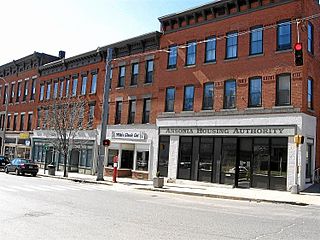
Ansonia is a city in New Haven County, Connecticut, United States. Located on the Naugatuck River, it is immediately north of Derby, and about 12 miles (19 km) northwest of New Haven. The city is part of the Naugatuck Valley Planning Region. The population was 18,918 at the time of the 2020 census. The ZIP code for Ansonia is 06401. The city is served by the Metro-North Railroad. Ansonia Station is a stop on the railroad passenger commuter service's Waterbury Branch connecting to New York's Grand Central Terminal. Ansonia also is served by the Connecticut Transit bus carrier. Connecticut Route 8 serves Ansonia.
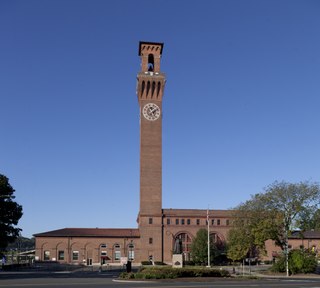
The Waterbury Union Station building is located on Meadow Street in the city of Waterbury, Connecticut, United States. It is a brick building dating to the first decade of the 20th century. Its tall clock tower, built by the Seth Thomas Company, is the city's most prominent landmark.

Two 19th century factory buildings are sited on a bank beside Starr Mill pond on Beverly Heights just off Middlefield Street. Each building is 3½ stories tall, and overlooks a picturesque pond and woods to the west; a parking lot packed with trucks and industrial equipment on the south; and nineteenth century housing on Beverly Heights to the north.

The Main Street Historic District in Danbury, Connecticut, United States, is the oldest section of that city, at its geographical center. It has long been the city's commercial core and downtown. Its 132 buildings, 97 of which are considered contributing properties, include government buildings, churches, commercial establishments and residences, all in a variety of architectural styles from the late 18th century to the early 20th. It is the only major industrial downtown of its size in Connecticut not to have developed around either port facilities or a water power site.

The Whitney Avenue Historic District is a historic district in the East Rock neighborhood of New Haven, Connecticut. It is a 203-acre (82 ha) district which included 1,084 contributing buildings when it was listed on the National Register of Historic Places in 1989.

The Southbridge-Sargent Manufacturing District encompasses a collection of three 19th-century factory buildings near a historically important railroad junction in southern Worcester, Massachusetts. They were built near the intersection of Sargent and Gold Streets, just south of Southbridge Street. The location is close to a junction of three major railroads: the Boston and Albany, the Norwich and Worcester, and the New York, New Haven, and Hartford. The area was once a major industrial part of the city, but has lost many of its historic factory buildings in the 20th century.

The Whitneyville Congregational Church, now the Whitneyville United Church of Christ, is a historic Congregational Church at 1247-1253 Whitney Avenue in the Whitneyville section of Hamden, Connecticut. The congregation is now affiliated with the United Church of Christ (UCC). The church building is a Greek Revival style built in 1834, with an interior altered in 1866 to designs by Rufus G. Russell. The church, along with its 1924 parish house, was added to the National Register of Historic Places in 1995 for its architecture.

The Strouse, Adler Company Corset Factory is a historic factory complex at 78-84 Olive Street in New Haven, Connecticut. Developed between 1876 and 1923, it was the largest and oldest of the city's several corset manufacturers, and remained in continuous operation for that purpose until 1998. The complex was listed on the National Register of Historic Places in 2002. It has since been converted into residential use.
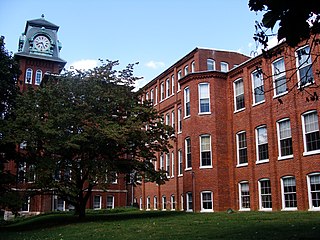
The Hamilton Watch Complex is a former industrial complex in Lancaster, Pennsylvania. It was owned by the Hamilton Watch Company and was used as their headquarters from the company's founding in 1892, until 1980. The complex was listed on the National Register of Historic Places in 1982. The main building was converted into a luxury apartment and condominium complex, while the Administrative Offices are now home to a Montessori school called "New School Montessori."
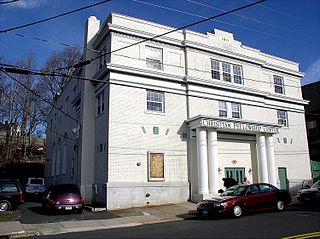
The Main Street Historic District of Bristol, Connecticut encompasses much of the city's central business district, an area built up in the late 19th and early 20th centuries. The district's 19 historic buildings are located along adjoining stretches of Main and Prospect Streets, and include important civic and commercial buildings. The district was listed on the National Register of Historic Places in 1995.

Frog Hollow is one of the neighborhoods of Hartford, Connecticut. It is a predominantly working-class residential area, bounded on the north by Capitol Avenue, the east by Lafayette Street, the south by Madison and Hamilton Streets, and on the west by Interstate 84. The neighborhood was developed between about 1850 and 1930, and still contains a remarkable concentration of residential housing from that period. The entire neighborhood, covering more than 150 acres (61 ha) and including more than 900 buildings, is listed on the National Register of Historic Places.

Sohmer and Company Piano Factory is a historic piano factory located in the Astoria neighborhood of Queens, New York City. It was built in 1886 by Sohmer & Co., and is a six-story, "L"-shaped, Rundbogenstil / Romanesque Revival style brick building. The corner features a clock tower with a copper trimmed mansard roof. The building was expanded about 1906–1907. It was converted to residential usage starting in 2007.
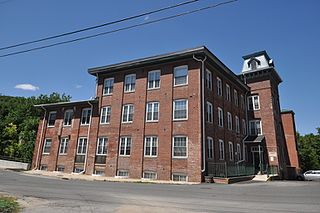
The Gilbert Clock Factory is a historic factory complex at 13 Wallens Street in Winsted, Connecticut. Developed between 1871 and 1897, its surviving elements are a preservation of the state's history as a center for the manufacture of low-cost clocks. The company was one of the town's largest employers for many years. The surviving buildings were listed on the National Register of Historic Places in 1984; they now house apartments.

Parkville is a neighborhood on the west side of Hartford, Connecticut. Centered on Park Street and stretching from the railroad overpass just west of Pope Park to the West Hartford town line, and Capitol Avenue to Interstate 84, Parkville is a densely developed, mixed-use neighborhood that is mainly working-class. Its name is derived from its placement at the junction of the North and South Branches of the now-subterranean Park River. Most of the eastern half of the neighborhood was listed as a historic district on the National Register of Historic Places in 2015.
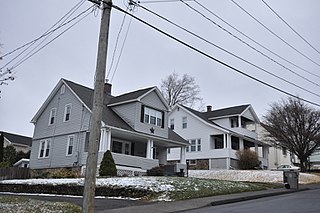
The South End Historic District encompasses one of the oldest residential areas of Bristol, Connecticut. Extending south from South Street along George and Hull Streets, this area's growth as a residential area's mirror's the city's growth as an industrial center from the second quarter of the 19th century, and includes a well-preserved diversity of residential architecture to the mid-20th century. It was listed on the National Register of Historic Places in 2001.
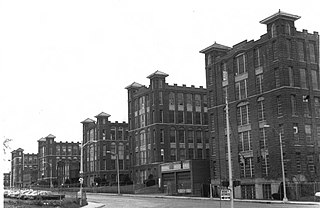
The Royal Typewriter Company building was located at 150 New Park Avenue in the Parkville neighborhood of Hartford, Connecticut. Built in 1907, it was the principal manufacturing facility of the Royal Typewriter Company, a major local employer, until 1972. Most of the building was destroyed by fire in 1992; the remainder was subsequently razed and the site now houses a shopping center, where a commemorative plaque is located. The building, which was one of the city's largest examples of late 19th-century mill construction, was listed on the National Register of Historic Places in 1989.

The M. Armstrong and Company Carriage Factory is a historic carriage factory building at 433 Chapel St. in New Haven, Connecticut. Built in 1882, it is one of a small number of surviving 19th-century carriage factories in a city that once had more than 50 such businesses. It was listed on the National Register of Historic Places in 2011.

The Matthews and Willard Factory was a historic industrial site at Cherry Avenue and North Elm Street in Waterbury, Connecticut. Founded in 1874, Matthews and Willard contributed to the expansion of Waterbury's brass processing industry. The plant remained little altered from its last period of expansion c. 1900, and was a good example of period industrial architecture. It was listed on the National Register of Historic Places in 1988, and was demolished in 2012. As of 2018, the site stands vacant.

The Upper Main Street Historic District encompasses a collection of mainly late-19th-century commercial buildings on Main Street in downtown Ansonia, Connecticut. Extending south from Maple Street, the district exemplifies the rapid commercial growth of the city at that time. Its most prominent feature is the Ansonia Opera House, built 1870. The district was listed on the National Register of Historic Places in 1982.
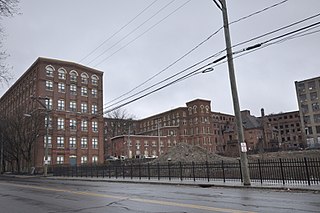
The Waterbury Clock Company factory is a historic complex of factory buildings in Waterbury, Connecticut. Developed beginning in the 1873, the extensive plant served as the company's main manufacturing facility and headquarters until 1944. The company is now known as the Timex Group USA, and was for a time one of the world's largest manufacturers of pocket watches. The surviving elements of the manufacturing complex were listed on the National Register of Historic Places in 1982. The property has since been subdivided and is home to a variety of primarily industrial or commercial uses.





















